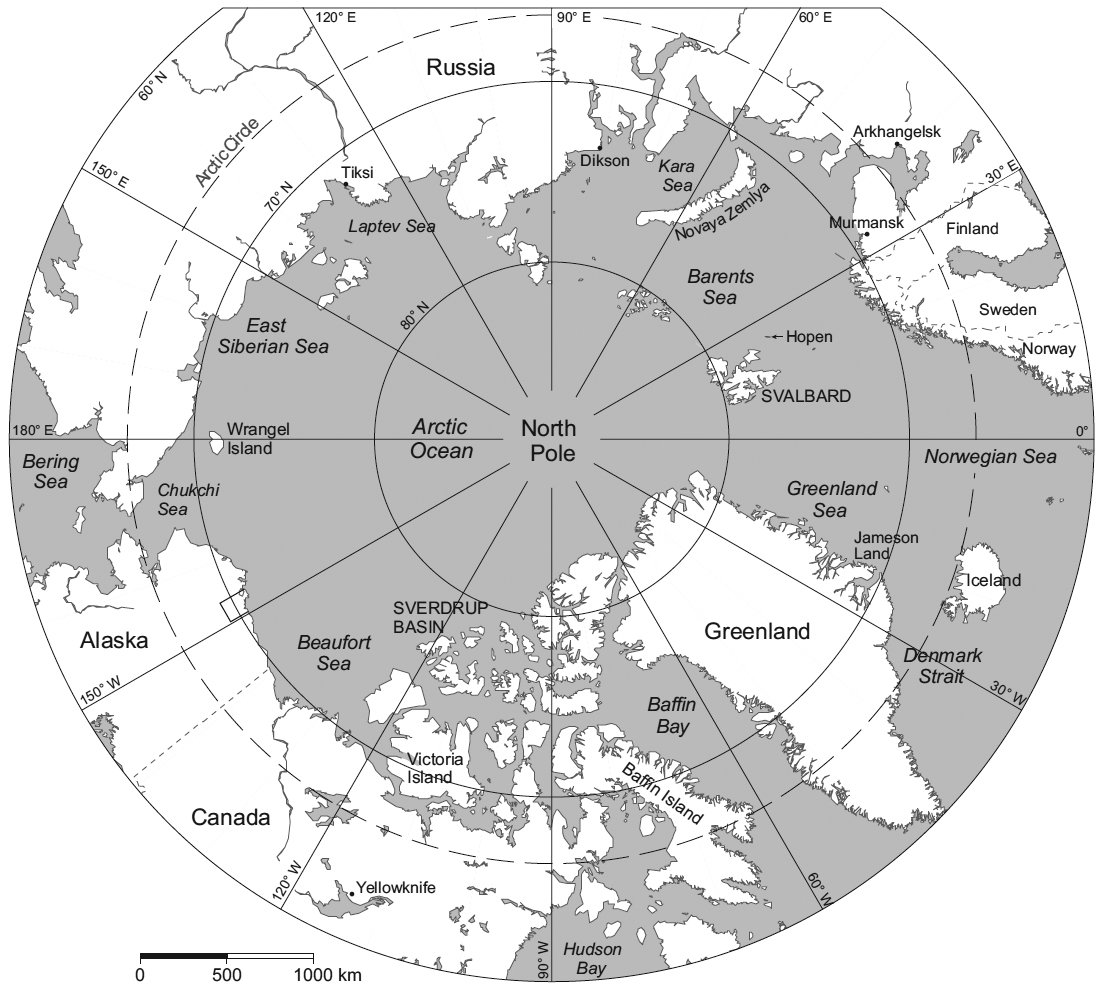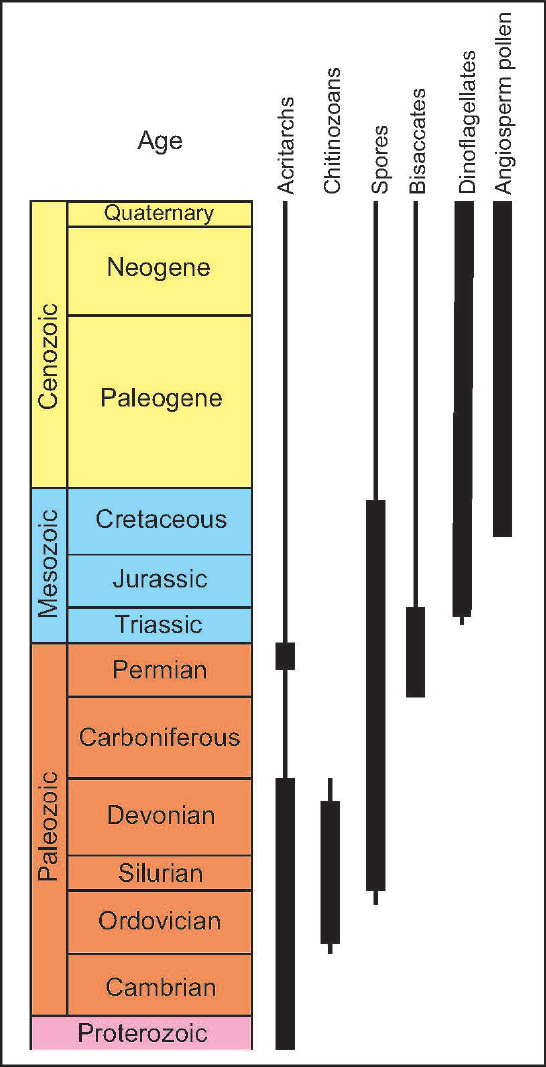Article
Introduction to the “Circum-Arctic Palynological Event Stratigraphy” (CAPE) series of papers
doi:10.4138/atlgeol.2021.001
Abstract
Palynomorphs are one of the few groups of fossils that provide biostratigraphic control in marine to nonmarine rocks and can be applied as proxies for paleoenvironmental and paleoclimatic interpretations. Their utility is enhanced by their microscopic size, which is usually less than 200 micrometres; they are thus easily recovered from small rock samples. They occur throughout the Phanerozoic and are therefore invaluable in refining biostratigraphic control of Arctic successions in Alaska, Arctic Canada, Greenland, northern Europe, and northern Russia. The objective of the Circum-Arctic Palynological Event (CAPE) Stratigraphy series of papers is to integrate data published on Arctic palynomorphs to delineate palynological events (palynoevents) across the Arctic for the Silurian to Cenozoic. Once the series of papers is complete, the data will also be used to compile a TimeScale Creator datapack that can be updated and calibrated on an ongoing basis. Palynoevents include taxon originations (first occurrences or FOs) and extinctions (last occurrences, or LOs) and some abundance events. The palynoevents are correlated with established chronostratigraphic horizons such as bases of ammonoid zones or stages, and hence their chronostratigraphy is independent of the absolute time scale in millions of years. In addition to the palynostratigraphic papers, the series includes a paper detailing the paleogeography of the circum-Arctic regions, including informative maps, as well as a paper providing a palynological perspective of the Cenozoic shift from greenhouse to icehouse conditions.
Résumé
Les palynomorphes sont l’un des rares groupes de fossiles qui permettent un contrôle biostratigraphique dans les roches marines et non marines et qui peuvent servir de témoins pour les interprétations paléoenvironnementales et paléoclimatiques. Leur utilité se trouve améliorée par leur taille microscopique, qui est habituellement de moins de 200 micromètres; ils sont ainsi facilement récupérés des petits échantillons de roches. Ils sont présents durant tout le Phanérozoïque et sont par conséquent d’une valeur inestimable pour le raffinement du contrôle biostratigraphique des successions arctiques en Alaska, dans l’Arctique canadien, au Groenland, dans le nord de l’Europe et dans le nord de la Russie. La série d’articles sur la stratigraphie des phénomènes palynologiques circumarctiques (PPC) vise l’intégration des données publiées sur les palynomorphes arctiques afin de dégager les phénomènes palynologiques (palynophénomènes) dans l’Arctique durant la période du Silurien au Cénozoïque. Une fois la série d’articles terminée, les données serviront à la compilation d’un dossier de données TimeScale Creator pouvant être mis à jour et étalonné de façon continue. Les palynophénomènes englobent les apparitions (premières manifestations ou PM) et les extinctions (dernières manifestations ou DM) de taxons, et certains phénomènes d’abondance. Les palynophénomènes sont corrélés avec des horizons chronostratigraphiques établis comme les bases de zones ou d’étages d’ammonites, et leur chronostratigraphie est donc indépendante de l’échelle chronologique absolue en millions d’années. Outre les articles palynostratigraphiques, la série comprend un article détaillant la paléogéographie des régions circumarctiques, y compris des cartes informatives, ainsi qu’un article fournissant une perspective palynologique du passage d’une période à effet de serre à des conditions à faible effet de serre durant le Cénozoïque.
[Traduit par la redaction]
INTRODUCTION
1 In the Circum-Arctic Palynological Event Stratigraphy project (CAPE), specialists were asked to document selected palynological events (for example taxon originations and extinctions) with correlation potential from the Silurian to the Cenozoic in the present-day Arctic region (Fig. 1). The results have been compiled into a series of papers in Atlantic Geology. The aim of the compilation is to develop a scheme of events across the Arctic tied to chronostratigraphic units and thus indirectly to the absolute time scale (Gradstein et al. 2020). The compilation thus develops a platform for stratigraphic studies, with flexibility for refinement and augmentation as additional information becomes available. The composite event scheme will contribute a refined timeframe to constrain interpretations of the geological evolution of the Arctic, a necessary precursor to various types of applied basin-fill studies.
 Display large image of Figure 1
Display large image of Figure 1
2 Palynology (or strictly paleopalynology) is the study of fossil organic-walled microfossils (palynomorphs), including pollen and spores, dinoflagellates, acritarchs, and chitinozoans. Due to their microscopic size, fossilizable walls and potential abundance in marine and nonmarine sedimentary rocks, palynomorphs are the single most effective group of fossils for correlation and environmental interpretations of Phanerozoic strata, especially for subsurface studies that involve small rock samples. The main groups of palynomorphs and their stratigraphic ranges are discussed in detail in Williams et al. (2018) (Fig. 2). In Neoproterozoic to Lower Devonian rocks, acritarchs (organic-walled, single-celled organisms of unknown affinity) are the primary biostratigraphic group, with chitinozoans also being a significant group for the Ordovician to Devonian interval. Acritarchs continue to be present through the Phanerozoic but are only occasionally important and of limited stratigraphic value after the Devonian. Spores, which first evolved in the Ordovician, are the foremost nonmarine group used in biostratigraphic studies of Upper Devonian to Permian rocks. Gymnosperm pollen (primarily conifers) became increasingly important from the Late Carboniferous to the Early Jurassic, whereas angiosperm (flowering plant) pollen did not enter the record, at least consistently, until the Early Cretaceous. Angiosperm pollen are generally more useful as paleoenvironmental rather than biostratigraphic indicators. Dinoflagellate cysts (dinocysts), which first occur in the latest Middle Triassic, are the most useful palynomorph group for biostratigraphy from the Middle Jurassic to the Holocene in marine sedimentary rocks. Hence the key palynomorph group(s) used to define events vary through geological time (Fig. 2).
 Display large image of Figure 2
Display large image of Figure 2
3 Most papers in the CAPE series describe palynoevents for today’s circum-Arctic region (Fig. 1) which includes Alaska, Arctic Canada, Greenland, northern Europe and northern Russia. Both onshore and offshore areas are included where data are available. Events from related areas, including the Labrador Sea, are incorporated when the assemblages are considered to represent Arctic populations. The location and geography of the modern circum-Arctic region varied during the Phanerozoic as plate-tectonic processes rearranged continental and oceanic components through time (Blakey 2021).
EVENT-BIOSTRATIGRAPHIC APPROACH AND TIMESCALE CREATOR
4 Most biostratigraphic studies of palynomorphs provide zonation schemes as a tool for stratigraphic correlation. While we recognize the value and advantages of zonation schemes, especially where a single scheme has remained relatively stable for many years (for example the standard western European ammonite zonation for the Jurassic), an event-stratigraphic scheme offers an alternative approach. Event schemes are more easily integrated with other parameters such as well logs (e.g., gamma-ray spikes), seismic markers, chemostratigraphic events (e.g., anoxic episodes) and other paleontological events. The papers in the CAPE series therefore propose event schemes for the Silurian to Cenozoic. Cambrian and Ordovician events have not been included due to current lack of data, but may be integrated in the future.
5 In the CAPE series of papers, selected markers comprise taxon origination events (first occurrences or FOs) and taxon extinction events (last occurrences or LOs). Some abundance events are included where they are considered useful for correlation: for example the FO of abundant monosaccate pollen is documented as the base of the Asselian (Mangerud et al. 2021b). The event schemes published in the CAPE series reflect the current state of knowledge and can be modified as knowledge of ranges become refined.
6 To facilitate this ongoing process, we plan to record all events as a datapack in TimeScale Creator (TSC; Geologic TimeScale Foundation 2021) that will be freely available online. TSC is a JAVA package operated by the Geologic TimeScale Foundation (GTS Foundation) based at Purdue University in West Lafayette, Indiana. It was developed to record stratigraphic data (including biostratigraphy, lithostratigraphy, and chronostratigraphy) and to update absolute ages in the geological time scale. Data presented in TSC are based on the Geological Time Scale (GTS) series of publications (the latest being Gradstein et al. 2020, which is used in the CAPE series of papers). The GTS Foundation provides regular updates that incorporate refinements to the absolute-age calibrations of chronostratigraphic units which are reflected in charts generated from TSC. These updates, together with the public availability of software and data, make TSC the ideal platform to store palynological event (palynoevent) data. Further details of how to use TSC are provided in the TSC website and Bringué et al. (in press).
7 To accommodate CAPE palynoevent data in TSC, it is necessary to define events relative to previously established chronostratigraphic units rather than absolute ages. The Geological Time Scale (Gradstein et al. 2020) is anchored to the stratigraphic record through “golden spikes” and type and reference sections, and its calibration in absolute time is continually being refined. Ideally, palynoevents should be tied to documented datums of other fossils groups, for example ammonites or planktonic foraminifera. An example is the FO of Jerseyiaspora punctispinosa, which in Mangerud et al. (2021c) occurs at the base of the ammonoid Keyserlingites subrobustus Zone. Note that relationships to bases are used for consistency and ease of application in TSC. If the palynoevent does not equate exactly with an independent horizon, then it is calibrated as a percentage above the base of a stratigraphic unit (e.g., an ammonoid zone or stage) relative to the next overlying unit of the same type. Thus, the LO of the spore genus Vittatina is documented as 70% up from the base of the Griesbachian Stage in Mangerud et al. (2021c). If a relationship with an independent fossil horizon cannot be identified, then a similar relationship with the base of a chronostratigraphic unit is employed. Thus, in Mangerud et al. (2021a), the FO of the spore Columinisporites heyleri is documented as the base of the Moscovian Stage; and the LO of the spore Microreticulatisporites nobilis is documented as 80% above the base of the Moscovian.
CONTENT OF THE CAPE SERIES OF PAPERS
8 The CAPE series will comprise articles on Silurian – Devonian, Carboniferous, Permian, Triassic, Jurassic and Cretaceous palynoevents, and one or more on Cenozoic palynoevents.. The series will also include an article detailing the paleogeography of the circum-Arctic region (Blakey 2021), and one documenting the effect of the Cenozoic greenhouse to icehouse climatic shift on Arctic palynological assemblages.
9 Each palynoevent paper has a section summarizing previous work, followed by documentation of the palynoevents, and how each event is tied to chronostratigraphy. Each contribution includes a present-day map of the circum-Arctic region showing locations cited in the paper, a stratigraphic chart generated by TSC showing the events, and a table summarizing the events as an appendix.
ACKNOWLEDGEMENTS
We are indebted to all authors of the CAPE set of papers who made the project possible. We are also grateful to Jim Ogg and Gabi Ogg for their advice on the use of TimeScale Creator; and to Eva Bjørseth (University of Bergen) and Bill MacMillan (Geological Survey of Canada–Atlantic), who helped draft the figures. We thank Manuel Bringué and Lynn Dafoe for incisive reviews that significantly improved this contribution; also Sandra Barr (Atlantic Geology coeditor) and Natalie Shea for helping us expedite its publication. This article is a contribution to the TransGEM event-stratigraphy activity of the Geological Survey of Canada’s Geo-mapping for Energy and Minerals Program. It is NRCan Contribution no. 20200615.
REFERENCES
Editorial responsibility: Sandra M. Barr
APPENDIX: TAXON NAMES WITH AUTHORSHIPS
Miospores
- Columinisporites heyleri (Doubinger 1968) Playford and Dino 2000
- Jerseyiaspora punctispinosa Kar et al. 1972
- Microreticulatisporites nobilis (Wicher 1934) Knox 1950
- Vittatina Samoilovich 1953 ex Wilson 1962